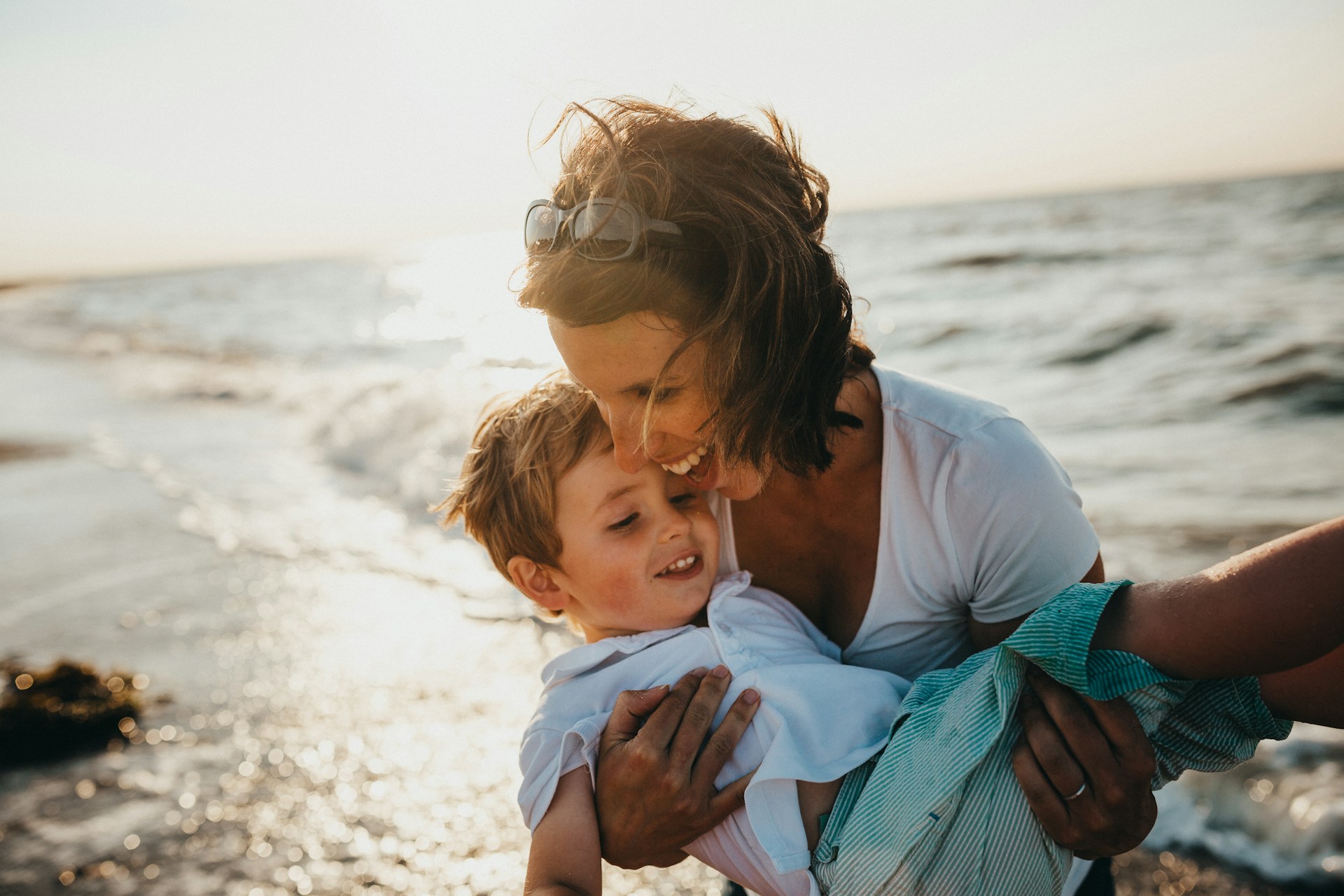As temperatures rise, parents often turn their attention to safe summer skin care for children.
While enjoying outdoor activities is important for children’s development, it is also important to ensure that their sensitive skin remains safe and healthy.
Which products should you use? That is not always an easy question. Years ago, parents just took what was on the shelf. But today we know that some ingredients in skin care products are not good for young skin.
Below, we’ll help you find a skincare routine for your little ones that you can feel confident about.
Safe Summer Skin Care for Kids: Beware of Sun Damage!
While it is not good for anyone to get a sunburn because it damages the skin, it is even worse for children to suffer from it.
That’s because sunburn during childhood can increase the risk of melanoma (the most aggressive form of skin cancer) later in life. The MD Anderson Center notes that just one or two burning sunburns doubles your child’s lifetime risk for melanoma. Children with pale skin, freckles and moles are at greater risk.
In general, children have less melanin (skin pigment) in their skin. Melanin protects against sun damage, so when there is less of it, children are more vulnerable. The outer layer of their skin is also thinner than that of adults. This makes them more sensitive to damage from UV radiation.
Dr. Gregory Walker of American Dermatology Partners in Waco, Texas, notes that skin damage is cumulative. “This means that the more sunburn a child or adolescent has, the greater the risk of serious health problems later in life.”
He adds that research from the Skin Cancer Foundation shows that five or more sun blisters between the ages of 15 and 20 can increase the risk of melanoma by 80 percent, and non-melanoma skin cancer by 68 percent.
Sun protection for children is crucial. But which sunscreen is safe?
Safe Summer Skin Care for Kids: Sunscreen and Sunscreen Recommendations
Children’s health recommends parents choose sunscreens with gentler, hypoallergenic ingredients that don’t contain harsh chemicals or fragrances that can irritate the skin. They also don’t recommend spraying on sunscreen because it puts children at risk of inhaling harmful chemicals. Lotions and creams are best.
It’s also important to note that many sunscreens have been recalled because they contain benzene, a chemical commonly used in industrial products but which can cause cancer with long-term exposure. The US Food and Drug Administration (FDA)FDA) has a list of the sunscreens that were recalled.
The Environmental Working Group (EWG) also warns that some chemicals used in sunscreens and other personal care products may have a greater impact on the health of children than that of adults because children’s bodies are still developing and do not yet have the defense mechanisms that adults have.
Both the EWG and CV Skinlabs recommend only zinc oxide or titanium dioxide sunscreen ingredients for children. These are mineral sunscreens that are safe and effective. Try to avoid formulas with chemical sunscreens like oxybenzone. If you don’t have access to a mineral sunscreen, use one with avobenzone. Avoid those with fragrance, retinyl palmitate, or retinol.
The EWG provides a handy list of The best-rated sunscreens for babies and children can be found here.
What if the children get burned?
Even if you do your best to protect your children and babies from too much sun, they can still get sunburned at some point.
Sunburned skin can be sensitive to the touch and feel sore and itchy. It will also probably look red and inflamed.
If your child does get sunburned, place a cool compress with tap water on top of the water for a few minutes. Then use our Rescue & Relief Spray formulated with aloe, oats, cucumber and water lily to soothe the burn and stop the itching. This cooling spray helps repair and relieve inflamed skin when the skin is too sensitive to touch.
Then use our gentle hypoallergenic moisturizers – Calming Moisture and Body Repair Lotion – to soothe redness, hydrate, help prevent peeling and regenerate the skin.
Safe Summer Skin Care for Kids: Other Skin Care Concerns
However, sunburn is not the only problem in summer. Children may also suffer from scrapes, wounds, insect bites, redness, heat rash and eczema flare-ups. How can a parent manage all this?
Below we have some tips for you! Most importantly, we want you to know that you can use all of our CV Skinlabs products for your children with complete peace of mind. Our products are specially formulated to be safe and effective for young skin, even newborns!
All our products have been rigorously tested to ensure they do not contain any potentially harmful ingredients or irritants. And they all contain our patented Tri-Rescue Complex: an anti-inflammatory blend of skin-soothing and wound-healing ingredients to keep skin healthy. Keep these essentials in your summer skincare arsenal for the whole family.
Insect bites, stings, poison ivy/plant rash and other sources of summer itch
To protect your child’s skin from possible insect bites, avoid going outside at dawn or dusk, when mosquitoes are more active.
Make sure children wear protective clothing and use insect repellent if necessary. The National Institutes of Health notes that DEET is safe for children two months and older when used as directed. Avoid products with sunscreen and DEET; apply these separately.
If your little one gets a bug bite, is bothered by plants, or suffers from any other type of summer itch, wash the area first and then apply a cold compress to help reduce swelling.
Trim your child’s fingernails and encourage your child not to scratch to avoid spreading a rash or infection. Then apply our Rescue & Relief Spray, which immediately soothes the itching. It contains aloe, oat extract and other soothing and healing ingredients that help quickly soothe redness, stinging and swelling.
Finally, apply our Restorative Skin Balm to reduce inflammation, promote healing and help prevent scarring. This multi-purpose balm also helps soothe cuts, scrapes and abrasions. It contains a powerful blend of botanicals that promote rapid healing and protect the skin from contaminants while regenerating the skin. It creates an occlusive yet breathable barrier to help heal cuts, scrapes, abrasions, burns, rashes, inflamed itchy patches and any other area that needs TLC.
If you notice any of the following symptoms, contact your child’s doctor:
- signs of an allergic reaction
- the bite does not heal within a few days
- your child is in a lot of pain
- signs of infection, fever or bull’s-eye rash due to a tick bite
Heat rash, chafing, diaper rash
If your young child sweats this summer, he or she may develop heat rash. You can help prevent this by keeping your child cool. Avoid long periods in the sun and encourage children to play in the shade. Dress them in loose-fitting, lightweight clothing made from breathable fabrics such as cotton. Make sure they drink enough water throughout the day.
If heat rash occurs, move your child to a cooler area, remove any sweaty clothing, rinse the area with cool water and then apply our Rescue + Relief Spray. It will cool and soothe the area while reducing itching and helping to hydrate the skin.
Then apply our award-winning Restorative Skin Balm, formulated with 100% natural ingredients. It provides a breathable skin barrier that protects the skin, helps reduce inflammation and redness, and soothes and heals rashes, burns and rough patches of skin.

Care after the pool: swimmer’s itch and eczema
The chlorine in swimming pools can cause dryness and irritation to your child’s skin. Overheating, sweating and chlorine can also aggravate conditions such as eczema, leading to increased itching and redness and causing flare-ups of dry, flaky skin.
Have your children shower immediately after swimming and then apply a good moisturizer to replenish lost moisture and protect against dehydration. We recommend our fragrance-free Body Repair Lotion and Calming Moisture as both are safe for children and provide long-lasting moisture. Calming Moisture is often recommended by dermatologists for the face, neck and scalp of newborn babies to soothe and help heal rashes and eczema.
Foot care
Summer often means barefoot activities, which can lead to rough or dry feet. Help your child care for their feet by:
- Keep toenails trimmed to prevent ingrown nails and fungal infections.
- Moisturize the feet regularly, especially the heels and soles, to prevent cracks and dehydration. Our Body Repair Lotion is ideal for this!
- Encourage the use of shoes and sandals in public areas to reduce the risk of infections such as athlete’s foot.
Skin care routine
Although young children usually have skin that is naturally hydrated and supple, even their skin can experience problems in hot and sunny weather. Maintain a simple skincare routine that includes gentle cleansing, moisturizing and sun protection. Teaching them at a young age the importance of taking care of their skin can help them develop lifelong skin care and sun protection habits.
Do you have more tips for safe summer skin care for children?
Featured image by Xavier Mouton Photography through Unsplash.





